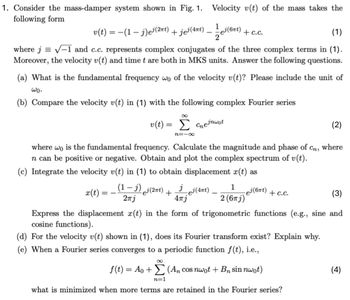
Elements Of Electromagnetics
7th Edition
ISBN: 9780190698614
Author: Sadiku, Matthew N. O.
Publisher: Oxford University Press
expand_more
expand_more
format_list_bulleted
Question

Transcribed Image Text:1. Consider the mass-damper system shown in Fig. 1. Velocity v(t) of the mass takes the
following form
v(t) = − (1 − j)e³(2πt) + jej (4πt)
1
-
ej(6πt)
+c.c.
2
(1)
where j√-1 and c.c. represents complex conjugates of the three complex terms in (1).
Moreover, the velocity v(t) and time t are both in MKS units. Answer the following questions.
(a) What is the fundamental frequency wo of the velocity v(t)? Please include the unit of
wo.
(b) Compare the velocity v(t) in (1) with the following complex Fourier series
8
v(t):
=
Σ Cejnwot
n=-∞
where wo is the fundamental frequency. Calculate the magnitude and phase of
In can be positive or negative. Obtain and plot the complex spectrum of v(t).
(c) Integrate the velocity v(t) in (1) to obtain displacement x(t) as
(2)
Сп
where
x(t) =
=-
(1-1) ej(2πt)
+
jej (4nt).
-
2πj
4πj
1
~ēj (6πt) + c.c.
2 (6πj)
(3)
Express the displacement x(t) in the form of trigonometric functions (e.g., sine and
cosine functions).
(d) For the velocity v(t) shown in (1), does its Fourier transform exist? Explain why.
(e) When a Fourier series converges to a periodic function f(t), i.e.,
8
f(t) = A0+(An cos nwot + B sin nwot)
n=1
what is minimized when more terms are retained in the Fourier series?
(4)
Expert Solution
This question has been solved!
Explore an expertly crafted, step-by-step solution for a thorough understanding of key concepts.
This is a popular solution
Trending nowThis is a popular solution!
Step by stepSolved in 2 steps with 6 images

Knowledge Booster
Similar questions
- Consider the mechanical energy equation: P + VB? + gzB =PA + V? + g ZA + w – loss A +g ZA + W – loss where loss 2 0 Select ALL true statements below. a fluid particle will flow through point A before point B a fluid particle will flow through point B before point A points A and B do not lie on the same streamline if a turbine is present, w < 0 if a pump is present, w < 0 if the fluid is perfectly inviscid, loss can be 0arrow_forwardPLEASE ANSWER QUICKLYarrow_forwardX Your answer is incorrect. The figure below provides steady-state data for water vapor flowing through a piping configuration where V1 = 35 m/s and T1 = 200°C. At each exit, the volumetric flow rate, pressure, and temperature are equal. P2= 4.8 bar T = 320°C Water vapor (AV)2 = (AV)3 V, T A1 = 0.2 m? Pi = 5 bar 3 P3 = 4.8 bar T3 = 320°C Determine the mass flow rate at the inlet and exits, each in kg/s. i 25.78 kg/s = i 12.89 kg/s m3 = i 12.89 kg/sarrow_forward
arrow_back_ios
arrow_forward_ios
Recommended textbooks for you
 Elements Of ElectromagneticsMechanical EngineeringISBN:9780190698614Author:Sadiku, Matthew N. O.Publisher:Oxford University Press
Elements Of ElectromagneticsMechanical EngineeringISBN:9780190698614Author:Sadiku, Matthew N. O.Publisher:Oxford University Press Mechanics of Materials (10th Edition)Mechanical EngineeringISBN:9780134319650Author:Russell C. HibbelerPublisher:PEARSON
Mechanics of Materials (10th Edition)Mechanical EngineeringISBN:9780134319650Author:Russell C. HibbelerPublisher:PEARSON Thermodynamics: An Engineering ApproachMechanical EngineeringISBN:9781259822674Author:Yunus A. Cengel Dr., Michael A. BolesPublisher:McGraw-Hill Education
Thermodynamics: An Engineering ApproachMechanical EngineeringISBN:9781259822674Author:Yunus A. Cengel Dr., Michael A. BolesPublisher:McGraw-Hill Education Control Systems EngineeringMechanical EngineeringISBN:9781118170519Author:Norman S. NisePublisher:WILEY
Control Systems EngineeringMechanical EngineeringISBN:9781118170519Author:Norman S. NisePublisher:WILEY Mechanics of Materials (MindTap Course List)Mechanical EngineeringISBN:9781337093347Author:Barry J. Goodno, James M. GerePublisher:Cengage Learning
Mechanics of Materials (MindTap Course List)Mechanical EngineeringISBN:9781337093347Author:Barry J. Goodno, James M. GerePublisher:Cengage Learning Engineering Mechanics: StaticsMechanical EngineeringISBN:9781118807330Author:James L. Meriam, L. G. Kraige, J. N. BoltonPublisher:WILEY
Engineering Mechanics: StaticsMechanical EngineeringISBN:9781118807330Author:James L. Meriam, L. G. Kraige, J. N. BoltonPublisher:WILEY

Elements Of Electromagnetics
Mechanical Engineering
ISBN:9780190698614
Author:Sadiku, Matthew N. O.
Publisher:Oxford University Press

Mechanics of Materials (10th Edition)
Mechanical Engineering
ISBN:9780134319650
Author:Russell C. Hibbeler
Publisher:PEARSON

Thermodynamics: An Engineering Approach
Mechanical Engineering
ISBN:9781259822674
Author:Yunus A. Cengel Dr., Michael A. Boles
Publisher:McGraw-Hill Education

Control Systems Engineering
Mechanical Engineering
ISBN:9781118170519
Author:Norman S. Nise
Publisher:WILEY

Mechanics of Materials (MindTap Course List)
Mechanical Engineering
ISBN:9781337093347
Author:Barry J. Goodno, James M. Gere
Publisher:Cengage Learning

Engineering Mechanics: Statics
Mechanical Engineering
ISBN:9781118807330
Author:James L. Meriam, L. G. Kraige, J. N. Bolton
Publisher:WILEY